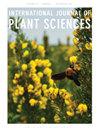记住它的起源:在种子生产过程中,母体效应影响了伞管的萌发反应、种子性状和初始根生长
IF 1.5
3区 生物学
Q3 PLANT SCIENCES
引用次数: 0
摘要
本文章由计算机程序翻译,如有差异,请以英文原文为准。
Remember its origin: maternal effects during seed production influence the germination responses, seed traits, and initial root growth of Piper umbellatum
Premise of research. Maternal environment can influence the seed ecophysiology, for example, of species that produce fruits in different seasons. Due to seasonal variations in environmental factors, differences in germination responses, seed traits, and seedling size may occur. Using seeds of Piper umbellatum produced in the same population in both the rainy and dry seasons, we evaluated the effects of temperature variations and water availability on germination parameters, root growth, and seed traits. Methodology. Eight temperature treatments (15°C, 20°C, 23°C, 25°C, 28°C, 30°C, 35°C, and alternation between 30°C and 20°C) and four water potentials (0, −0.3, −0.6, and −1.2 MPa) were performed. The following parameters were analyzed: germination onset, germination percentage (G%), mean germination time (MGT), root elongation, seed longevity during ex situ storage, and dry mass of seeds. Pivotal results. All parameters analyzed differed according to the seed production period. The rainy-season seeds had greater germinability and longevity, as they started to germinate first with higher G% and lower MGT values than the dry-season seeds, which were more sensitive to the effects of water deficit in relation to germination parameters. Dry-season seeds had higher dry mass, and their seedlings had greater root growth than those from rainy-season seeds. This balance between germination parameters and traits of seeds and seedlings reflects the existence of an intergenerational memory of stress. Conclusions. The maternal environment during the seed production period influenced germination responses, seed traits, and root growth. The first stages of plant development can be strongly impacted by climate change, and the responses to these changes can vary according to the period of seed production in the same species.
求助全文
通过发布文献求助,成功后即可免费获取论文全文。
去求助
来源期刊
CiteScore
4.50
自引率
4.30%
发文量
65
审稿时长
6-12 weeks
期刊介绍:
The International Journal of Plant Sciences has a distinguished history of publishing research in the plant sciences since 1875. IJPS presents high quality, original, peer-reviewed research from laboratories around the world in all areas of the plant sciences. Topics covered range from genetics and genomics, developmental and cell biology, biochemistry and physiology, to morphology and anatomy, systematics, evolution, paleobotany, plant-microbe interactions, and ecology. IJPS does NOT publish papers on agriculture or crop improvement. In addition to full-length research papers, IJPS publishes review articles, including the open access Coulter Reviews, rapid communications, and perspectives. IJPS welcomes contributions that present evaluations and new perspectives on areas of current interest in plant biology. IJPS publishes nine issues per year and regularly features special issues on topics of particular interest, including new and exciting research originally presented at major botanical conferences.

 求助内容:
求助内容: 应助结果提醒方式:
应助结果提醒方式:


